Brush Piles for Wildlife
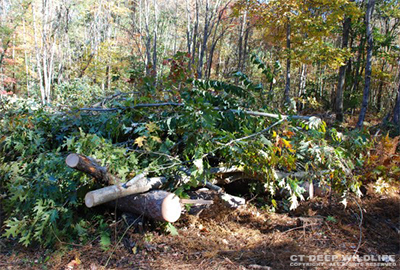
Definition
A brush pile is a mound or pile of appropriate woody material fashioned by piling brush and loose branches on top of a base comprised of larger logs or other natural materials.
Purpose
This practice is used to create cover for many songbirds, small mammals, reptiles, and amphibians when natural cover is limited, such as after clear-cutting. Brush piles provide areas for nesting, resting, escape from predators, and protection from harsh weather conditions.
Criteria, Considerations, and Specifications
Brush piles may be built to various dimensions based on the size of available material. However, the size should range between 10 to 20 feet on a side and 4 to 8 feet high.
Materials
Brush piles can be constructed using a variety of materials. Commonly, materials left from timber harvesting or any tree-cutting activity are used. Natural features, such as rocks, boulders, and stumps, may also be incorporated.
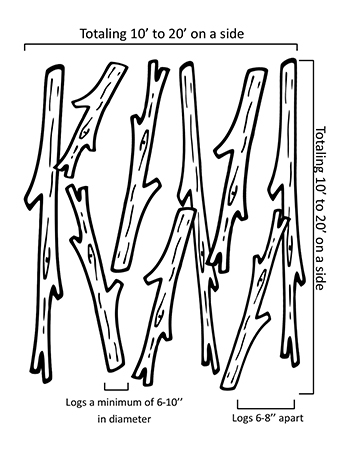 Construction
Construction
1. Base layer:
- Logs at a minimum of 6 to 10 inches in diameter are laid at various angles, leaving small openings (6 to 8 inches wide) between base logs for easy wildlife access. Alternate logs to create varying heights and avoid creating parallel runways through the base layer.
- Logs of various lengths (that add up to 10 to 20 feet on a side) can be staggered throughout the foundation, with breaks, creating a maze-like environment.
- Outer logs should be closer to 20 feet in length to provide stability for the brush pile.
2. A second layer of smaller diameter logs should be laid on top and roughly perpendicular to the first base layer, in the same fashion, and repeated with increasingly smaller logs, building 1 to 3 additional layers.
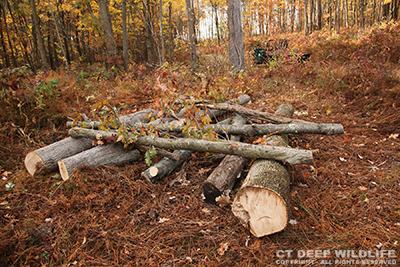
A second layer is laid on top of and roughly perpendicular to the first layer.
3. The foundation should be covered with 3 to 6 feet of brush, using small limbs, saplings, loose brush, and pine boughs. Larger branches should cover the foundation, with smaller branches placed on top.
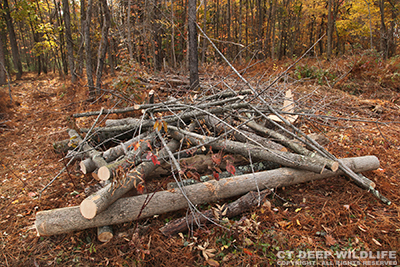
The foundation should be covered with brush, using increasingly smaller branches on top.
4. Brush should loosely drape over the edges, with openings (6 to 8 inches in diameter) left on the sides in several places for easy wildlife access and escape. Brush should cover the pile sufficiently so that the base is mostly covered. If available on site, add pine boughs, as the needles will persist after deciduous leaves fall off. You should not be able to see through the brush pile even after leaves have dropped from the branches.
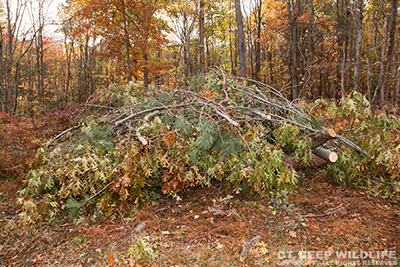
Add leafy crowns or boughs to the top of the pile.
NOTE: When constructing brush piles using mechanized forestry equipment, it is not possible to construct piles exactly as described. It is suitable if larger logs are crisscrossed on the base and covered with increasingly smaller logs and finally brush, so long as adequate spaces are left for wildlife to enter and exit the pile.
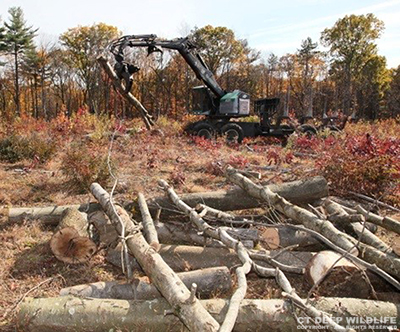
Construction of a brush pile using mechanized forestry equipment.
Placement
- Several considerations should be made when placing brush piles:
Multiple brush piles are better than one large pile, providing more opportunities for cover and escape from predators. - Good locations include adjacent to forest openings, pastures or hay fields; within shrub thickets or fencerows; in field corners; and near stonewalls and wetlands.
- On lands with little natural cover, such as recently cleared areas, begin brush piles within 25 feet of woodland edges and build in towards the center of the habitat patch, resulting in 1 to 3 brush piles per acre, evenly distributed across the project site.
- Place near wildlife food sources, such as mast and fruit trees.
- Avoid placing brush piles on existing high quality food or cover sources.
Avoid placing brush piles near homes, lawns, or gardens to prevent situations where wildlife could become a nuisance. - Keep away from buildings due to flammability.
- Cultural resources, such as stone walls, can be incorporated into a brush pile; however, stones should not be moved.
Variations of Brush Pile Base
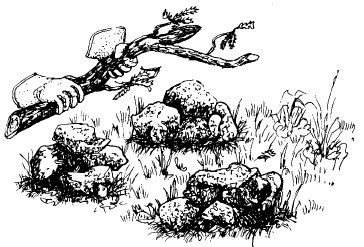 Tree stumps still in place can be incorporated into your brush pile base. Several logs (6 to 10 inches in diameter and 5 to 6 feet long) are placed on top of and around the stump.
Tree stumps still in place can be incorporated into your brush pile base. Several logs (6 to 10 inches in diameter and 5 to 6 feet long) are placed on top of and around the stump.
- Small rock piles should be staggered about 12 inches apart with each pile about 10 inches high and 12 inches across to support the next layer of limbs. Existing boulders and rocks on the landscape can be piled together to provide additional den sites. Start with the largest rocks on the bottom of the stack to create hiding places between the rocks, and stack brush on top for additional cover.
Other Types of Cover
(These do not meet criteria for reimbursement through the Natural Resource Conservation Service Program.)
- Living brush pile – in a cluster of small diameter trees, cut each tree half way through at a height of 12 to 18 inches above the ground; fold treetops inwards towards other trees in groups so they rest on the ground or on top of the other half-cut trees.
- Stonewalls – may be incorporated into the brush piles base; brush should be placed against the wall with similar dimensions and distribution to brush piles created in an open space.
- When harvesting trees, leave the crowns of the largest trees (e.g. an oak treetop) for wildlife cover.
- Windrowed brush piles – typically these linear brush piles can best be created after a forestry or tree removal operation. As with other brush pile creation, larger materials should be placed on the bottom at various angles with subsequently smaller material on top. Avoid packing the logs tightly, as this will eliminate any openings for wildlife to enter and exit the linear pile. Windrows should range from 10 to 20 feet on a side and 6 to 8 feet high. Windrows should have breaks built into them every 50 to 100 feet to provide travel lanes for wildlife.
Operation and Maintenance
- Monitor condition and/or usage of the structure.
- Conduct needed maintenance of the structure, such as periodically adding new material to the top of the pile.
Additional Notes
Brush piles are not permanent. New brush needs to be added over time or new piles may need to be constructed. Rot and decay are natural processes and may attract more insects, providing additional food sources.
Do not use materials that contain toxic substances (i.e. pressure treated lumber/posts, creosote railroad ties, lead painted surfaces, tires, etc.). These substances can cause wildlife mortality either through contact, consumption, or inhalation.
Content last updated on August 23, 2016.

